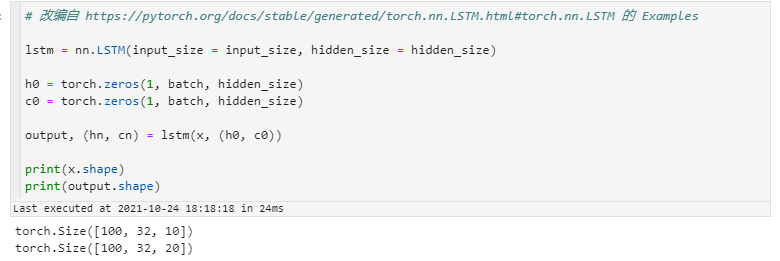LSTM使用基础
原理请自行学习
torch.nn.LSTMCell
torch.nn.LSTM
要了解 LSTM 如何工作,先了解 LSTMCell 如何工作
import numpy as np
import torch
import torch.nn as nn
batch = 32
seq_l = 100 # 序列长度
input_size = 10
# 创建一个数据
x = torch.randn(seq_l, batch, input_size)
hidden_size = 20
nn.LSTMCell
# 改编自 https://pytorch.org/docs/stable/generated/torch.nn.LSTMCell.html#torch.nn.LSTMCell 的 Examples
lstm_cell = nn.LSTMCell(input_size = input_size, hidden_size = hidden_size)
output = []
hx = torch.zeros(batch, hidden_size)
cx = torch.zeros(batch, hidden_size)
for i in range(seq_l):
hx, cx = lstm_cell(x[i], (hx, cx))
output.append(hx)
output = torch.stack(output, dim=0)
print(x.shape)
print(output.shape)

nn.LSTM
# 改编自 https://pytorch.org/docs/stable/generated/torch.nn.LSTM.html#torch.nn.LSTM 的 Examples
lstm = nn.LSTM(input_size = input_size, hidden_size = hidden_size)
h0 = torch.zeros(1, batch, hidden_size)
c0 = torch.zeros(1, batch, hidden_size)
output, (hn, cn) = lstm(x, (h0, c0))
print(x.shape)
print(output.shape)

关系
上面两段代码作用是一样的。一个是单元,一个是整体,前者使用更灵活,后者使用更方便。
从 LSTMCell 那段代码可以看出,output 本质上就是序列中每一步对应的隐藏层输出,看看LSTM是不是也是这样。
print(output.shape, hn.shape)
torch.all(output[-1] == hn[-1])

对吧
实战1 单步预测
数据总量:500
shape: (500, 2)
特征:第一列是 sin(x) , 第二列是cos(x)
目标:通过这些数据(0 ~ 500),预测第 500 ~ 1000 步的数据。
from tqdm import trange
import matplotlib.pyplot as plt
import numpy as np
import torch
import torch.nn as nn
plt.rcParams['font.sans-serif'] = ['SimHei']
plt.rcParams['axes.unicode_minus'] = False
np.set_printoptions(suppress=True)
class Data_Manager:
def __init__(self):
self.size = 500
self.x = np.linspace(0, self.size, num=self.size)
# shape: (self.size, 2)
self.X = np.vstack([
np.sin(self.x / 2 / np.pi),
np.cos(self.x / 2 / np.pi)
]).T
plt.figure(figsize=(35, 7))
plt.plot(self.x, self.X[:, 0], color='r')
plt.plot(self.x, self.X[:, 1], color='b')
dm = Data_Manager()

class Model(nn.Module):
def __init__(self):
super().__init__()
self.input_size = 2
self.output_size = 2
self.hidden_size = 64
self.lstm = nn.LSTM(
input_size = self.input_size,
hidden_size = self.hidden_size
)
self.l = nn.Sequential(
nn.Linear(self.hidden_size, self.hidden_size),
nn.Linear(self.hidden_size, self.hidden_size),
nn.Linear(self.hidden_size, self.output_size)
)
def forward(self, x):
# N = batch_size, L = sequence length 即序列长度
x = x.permute(1, 0, 2) # (N, L, 2) -> (L, N, 2)
output, (hn, cn) = self.lstm(x) # (L, N, 2) -> (L, N, hidden_size), ((1, N, hidden_size), (1, N, hidden_size))
x = hn[-1] # (1, N, hidden_size) -> (N, hidden_size)
x = self.l(x) # (N, hidden_size) -> (N, output_size)
return x
model = Model()
optimizer = torch.optim.Adam(model.parameters())
Len_t = 5 # 用长度为 5 的序列
Len_p = 1 # 单步预测
Len = Len_t + Len_p
epochs = 10000
e = len(str(epochs))
pbar = trange(epochs)
for epoch in pbar:
i = np.random.randint(0, dm.size - Len) # 随机挑选数据进行训练
datas = dm.X[i:i+Len]
# datas 的 shape: (6, 2)
x = torch.tensor(datas[:Len_t], dtype=torch.float32).unsqueeze(0) # 训练数据 shape: (1, 5, 2)
y = torch.tensor(datas[Len_t:], dtype=torch.float32) # 答案数据(也可以理解为标签) shape: (1, 2)
y_pred = model(x) # shape: (1, 2)
y_true = y # shape: (1, 2)
loss = nn.MSELoss()(y_pred, y_true).mean()
optimizer.zero_grad()
loss.backward()
optimizer.step()
pbar.set_description(f'[Epoch: {epoch+1:>{e}}/{epochs:>{e}}] [loss {loss.item():.3f}]')
- 用最后 Len_t 行数据 x, 预测下一步的数据 y
- 把 y 加入到 x 的最后一行,然后去掉 x 最前面一行
- 用 x 预测下一步的数据 y
- 重复步骤 2 和 步骤 3 直到结束
X_pred = np.array([])
for i in range(0, 500):
if i == 0:
x = torch.tensor(dm.X[-Len_t:], dtype=torch.float32).unsqueeze(0)
else:
x = torch.tensor(x_new, dtype=torch.float32).unsqueeze(0)
# 预测下一步
y = model(x).detach().cpu().numpy()
# 保存
if X_pred.shape[0] == 0:
X_pred = y
else:
X_pred = np.vstack([X_pred, y])
# shape: (5, 2) -> 合并预测数据 (6, 2) -> 删掉最前面的数据 (5, 2)
x_new = np.vstack([x.detach().cpu().numpy()[0], y])[1:]
fig, ax = plt.subplots(figsize=(70, 7))
ax.plot(dm.x, dm.X[:, 0], color='red')
ax.plot(dm.x, dm.X[:, 1], color='blue')
ax.plot(np.arange(dm.size, dm.size + X_pred.shape[0]), X_pred[:, 0], color='darkred')
ax.plot(np.arange(dm.size, dm.size + X_pred.shape[0]), X_pred[:, 1], color='darkblue')
plt.show()

前面半段是原始数据,后面半段是预测数据(颜色较暗)。
实战2 多步预测
注:这个代码本质上还是单步预测,只不过是由多个单步预测组成的多步预测而已
from tqdm import trange
import matplotlib.pyplot as plt
import numpy as np
import torch
import torch.nn as nn
plt.rcParams['font.sans-serif'] = ['SimHei']
plt.rcParams['axes.unicode_minus'] = False
np.set_printoptions(suppress=True)
class Data_Manager:
def __init__(self):
self.size = 500
self.x = np.linspace(0, self.size, num=self.size)
# shape: (self.size, 2)
self.X = np.vstack([
np.sin(self.x / 2 / np.pi),
np.cos(self.x / 2 / np.pi)
]).T
plt.figure(figsize=(35, 7))
plt.plot(self.x, self.X[:, 0], color='r')
plt.plot(self.x, self.X[:, 1], color='b')
dm = Data_Manager()
class Model(nn.Module):
def __init__(self, output_len):
super().__init__()
self.input_size = 2
self.output_size = 2
self.hidden_size = 64
self.output_len = output_len
self.lstm_cell = nn.LSTMCell(
input_size = self.input_size,
hidden_size = self.hidden_size
)
self.l = nn.Sequential(
nn.Linear(self.hidden_size, self.hidden_size),
nn.Linear(self.hidden_size, self.hidden_size),
nn.Linear(self.hidden_size, self.output_size)
)
def forward(self, x):
# N = batch_size, L = sequence length 即序列长度
x = x.permute(1, 0, 2) # (N, L, 2) -> (L, N, 2)
h0 = torch.zeros(x.size(1), self.hidden_size)
c0 = torch.zeros(x.size(1), self.hidden_size)
output = []
for i in range(x.size(0) + self.output_len):
if i < x.size(0):
hx, cx = self.lstm_cell(x[i], (h0 if i ==0 else hx, c0 if i ==0 else cx))
else:
hx, cx = self.lstm_cell(output[i-1], (hx, cx))
output.append(self.l(hx))
x = torch.stack(output[5:], dim=0) # shape: (L+output_len, N, 2) -> (output_len, N, 2)
x = x.permute(1, 0, 2) # shape: (output_len, N, 2) -> (N, output_len, 2)
return x
Len_t = 5 # 用长度为 5 的序列
Len_p = 5 # 多步预测
Len = Len_t + Len_p
model = Model(Len_p)
optimizer = torch.optim.Adam(model.parameters())
epochs = 10000
e = len(str(epochs))
pbar = trange(epochs)
for epoch in pbar:
i = np.random.randint(0, dm.size - Len) # 随机挑选数据进行训练
datas = dm.X[i:i+Len]
# datas 的 shape: (6, 2)
x = torch.tensor(datas[:Len_t], dtype=torch.float32).unsqueeze(0) # 训练数据 shape: (1, 5, 2)
y = torch.tensor(datas[Len_t:], dtype=torch.float32).unsqueeze(0) # 答案数据(也可以理解为标签) shape: (1, 5, 2)
y_pred = model(x) # shape: (1, 5, 2)
y_true = y # shape: (1, 5, 2)
loss = nn.MSELoss()(y_pred, y_true).mean()
optimizer.zero_grad()
loss.backward()
optimizer.step()
pbar.set_description(f'[Epoch: {epoch+1:>{e}}/{epochs:>{e}}] [loss {loss.item():.3f}]')
X_pred = np.array([])
for i in range(0, 500 // Len_p):
if i == 0:
x = torch.tensor(dm.X[-Len_t:], dtype=torch.float32).unsqueeze(0)
else:
x = torch.tensor(x_new, dtype=torch.float32).unsqueeze(0)
# 预测下一步
y = model(x).detach().cpu().numpy()[0]
# 保存
if X_pred.shape[0] == 0:
X_pred = y
else:
X_pred = np.vstack([X_pred, y])
# shape: (5, 2) -> 合并预测数据 (10, 2) -> 删掉最前面的数据 (5, 2)
x_new = np.vstack([x.detach().cpu().numpy()[0], y])[Len_t:]
fig, ax = plt.subplots(figsize=(70, 7))
ax.plot(dm.x, dm.X[:, 0], color='red')
ax.plot(dm.x, dm.X[:, 1], color='blue')
ax.plot(np.arange(dm.size, dm.size + X_pred.shape[0]), X_pred[:, 0], color='darkred')
ax.plot(np.arange(dm.size, dm.size + X_pred.shape[0]), X_pred[:, 1], color='darkblue')
plt.show()

前面半段是原始数据,后面半段是预测数据(颜色较暗)。